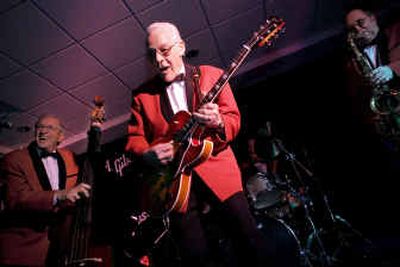It’s still rocking after 51 years

The record that announced the arrival of rock ‘n’ roll to the world was recorded in an Upper West Side church 51 years ago this week by a guy who looked like a Rotarian, under a producer who still carried a torch for Billie Holiday.
The song was rush-recorded in the last few minutes of a session. When it was released on the B-side of a novelty tune, it spent a single week on the lower reaches of the pop charts and disappeared.
The guitarist whose solo was the most distinctive feature of the record died of a heart attack a few months later, assuming the thing had stiffed.
But “Rock Around the Clock” was not about to disappear that easily.
A half century later, not a day goes by when someone somewhere doesn’t snap his or her fingers as Billy Guesak cracks three rim shots and Bill Haley calls off the countdown to a new musical world:
“One two three o’clock four o’clock rock
“Five six seven o’clock,
“Eight o’clock rock
“Nine 10 11 o’clock,
“12 o’clock rock
“We gonna rock … around … the clock tonight”
Bill Haley, a country boy from Pennsylvania, was the unlikeliest of rock ‘n’ roll icons, yin to Elvis Presley’s yang. Where Elvis was everything cool and hip, Haley looked like the lantern-jawed lawman in a B Western, all smile and spit-curl.
But he was a music professional, and as the frontman for a country band called the Saddlemen, he had stirred up enough excitement to interest songwriter/entrepreneur Jimmy Myers and Decca Records.
Early in 1953, Myers bought “Rock Around the Clock” from a freelance songwriter named Max Freedman, put his name on it and gave it to Haley.
That summer Haley and his band settled in for a long residency in Wildwood, N.J., and once they discovered what a crowd-pleaser they had on their hands, “Rock” became a centerpiece of their act.
The band was signed at the time to a small Essex, N.Y., label, whose president didn’t get along with Myers and so refused to record the song. In the spring of 1954, however, Haley signed with Decca, where he was paired up with producer Milt Gabler, an old-time jazz guy who had recorded Holiday, Coleman Hawkins, Louis Jordan and hundreds of others.
If his heart lay with jazz, though, Gabler could see what was coming. Jordan’s hot combo sound was already pointing music toward what would become rock ‘n’ roll, and in Haley, Gabler had a white guy he figured could get through some doors that Jordan probably couldn’t.
And so Gabler arranged a session for April 12 at the Pythian Temple, 135 W. 70th St. in New York. The place had cathedral ceilings, wooden floors and a big-band-size stage. Gabler thought it would be perfect for Haley and his group, now called the Comets, because it simulated a live setting.
But Gabler wasn’t thinking about “Rock Around the Clock.” The record he wanted to nail at this session was “Thirteen Women,” a novelty tune about the post-atomic bomb world in which the survivors were 13 women and one man.
“Rock Around the Clock” was on the board only because every new release needed a B side. Indeed, the song had been sitting around so long that two other versions had already come out: one by Sonny Dae and the Knights and the other a big band arrangement by Myers himself, as Jimmy DeForrest.
So when they finished “Thirteen Women,” Gabler, with some backseat driving by Myers, quickly reset the band, gave them one run-through and turned on the tape machine.
Still, Gabler gave it a fresh production. Taking full advantage of the room’s booming sound and the sharp echoes off the high ceilings, he told the skeptical engineers to “let the needles ride into the red.” This deliberately distorted the sound, an unheard-of concept at the time.
Since Haley had performed the song countless times live, the band was ready, and having Guesak as their hired session drummer gave the song another new edge.
The guitar solo, which would eventually inspire hundreds of guitarists around the world, was a fast, crisp run by Haley’s regular guitarist, Danny Cedrone. It was also an almost note-for-note copy of a solo he had played two years earlier on a Haley record called “Rock This Joint.”
Decca released the record in May, billing it as a “fox-trot.” It went to No. 23 on the charts and then died.
Late that summer, Cedrone died, too, of a heart attack.
Myers, however, stayed on the case. He carted the record around to radio stations and sent out 200 copies to movie studios.
He got back one response. That was from the producers of a juvenile delinquent film called “The Blackboard Jungle,” which was set in a New York high school and starred Glenn Ford as a besieged teacher.
“Rock Around the Clock” didn’t seem to have much to do with the picture. But when it blasted over the opening credits, it signaled that rock ‘n’ roll was here and there wasn’t much that anybody could do about it.
Decca re-released Haley’s recording as a single in March 1955, and it shot to No. 1, where it remained most of the summer.
By the time it slipped off the charts this time, RCA Records had decided to take a chance on Elvis Presley.